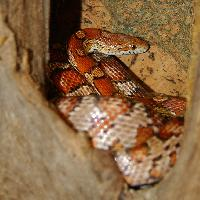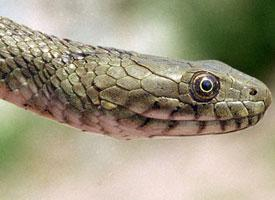
Poids et mesures
| Longueur | de 90 à 120 cm |
|---|
Description de l'animal
The Common Trinket Snake (Elaphe helena), also known as the Helena's Rat Snake, is a captivating species of non-venomous snake native to South Asia. This species is renowned for its striking appearance and adaptability, making it a fascinating subject of study for herpetologists and a popular choice among reptile enthusiasts.Physically, the Common Trinket Snake exhibits a slender and muscular build, allowing for swift and agile movement through its environment. Adults typically reach lengths of about 100 to 180 centimeters (3.3 to 5.9 feet), although size can vary based on factors such as diet and habitat. The skin of Elaphe helena is adorned with a remarkable pattern that contributes to its common name. The base coloration ranges from a rich brown to a dark, almost black hue, overlaid with lighter, often golden or tan, saddle-like markings and stripes that run the length of its body. This distinctive patterning not only adds to the snake's aesthetic appeal but also serves as camouflage, helping it blend into the forest floor and underbrush of its natural habitat.
The head of the Common Trinket Snake is slightly distinct from its body, with a sharper, somewhat angular shape that houses keen eyes with round pupils. This visual acuity is essential for hunting and navigation within its environment. The snake's diet is versatile, consisting primarily of rodents, small birds, and occasionally other reptiles. Its hunting strategy combines both active pursuit and ambush tactics, depending on the prey and the situation.
Elaphe helena is found across a broad range of South Asia, inhabiting countries such as India, Nepal, Bangladesh, and Pakistan. Its preferred habitats include forests, grasslands, and the outskirts of agricultural areas, where it can often be found hiding under rocks, in tree hollows, or within piles of debris. The species is known for its adaptability, capable of thriving in both moist and dry environments, although it tends to avoid extremely arid conditions.
Reproduction in the Common Trinket Snake is oviparous, meaning the species lays eggs rather than giving birth to live young. The breeding season typically occurs after the onset of the monsoon, with females laying clutches of 5 to 10 eggs. These eggs are often deposited in hidden, secure locations such as hollow logs or under dense vegetation. The incubation period lasts approximately 60 to 70 days, after which the hatchlings emerge, fully independent and capable of fending for themselves.
While not considered currently endangered, the Common Trinket Snake faces threats from habitat destruction and the pet trade. Deforestation and the expansion of agriculture reduce the available natural habitat, while capture for sale as exotic pets can deplete local populations. Conservation efforts focus on habitat preservation and regulation of the pet trade to ensure the species' survival.
In summary, the Common Trinket Snake is a remarkable and beautiful reptile, valued both for its ecological role and its visual appeal. Its adaptability and wide range have helped it to survive in a changing world, but it remains subject to the pressures of human activity. Through continued conservation efforts, it is hoped that this species will continue to thrive in its natural habitat for generations to come.
Animaux similaires
Nouvelles photos d'animaux
Top 10 des animaux
- Dolphin gull (Leucophaeus scoresbii)
- Diana monkey (Cercopithecus diana)
- Moustached guenon (Cercopithecus cephus)
- Galápagos tortoise (Geochelone nigra complex)
- Russian tortoise (Testudo horsfieldii)
- Stone loach (Barbatula barbatula)
- Japanese macaque (Macaca fuscata)
- Greek tortoise (Testudo graeca)
- Common flying dragon (Draco volans)
- Vendace (Coregonus albula)


